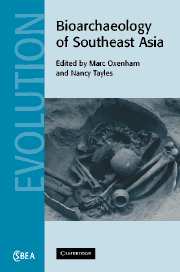Book contents
- Frontmatter
- Contents
- List of contributors
- Foreword: Emerging frontiers in the bioarchaeology of Southeast Asia
- Preface
- 1 Introduction: Southeast Asian bioarchaeology past and present
- Part I Morphological diversity, evolution and population relationships
- Part II Health, disease and quality of life
- 8 Subsistence change and dental health in the people of Non Nok Tha, northeast Thailand
- 9 Human biology from the bronze age to the iron age in the Mun River valley of northeast Thailand
- 10 Palaeodietary change among pre-state metal age societies in northeast Thailand: a study using bone stable isotopes
- 11 The oral health consequences of the adoption and intensification of agriculture in Southeast Asia
- 12 Cranial lesions on the late Pleistocene Indonesian Homo erectus Ngandong 7
- 13 ‘The predators within’: investigating the relationship between malaria and health in the prehistoric Pacific Islands
- Part III Conclusions
- Index
- References
12 - Cranial lesions on the late Pleistocene Indonesian Homo erectus Ngandong 7
Published online by Cambridge University Press: 18 November 2009
- Frontmatter
- Contents
- List of contributors
- Foreword: Emerging frontiers in the bioarchaeology of Southeast Asia
- Preface
- 1 Introduction: Southeast Asian bioarchaeology past and present
- Part I Morphological diversity, evolution and population relationships
- Part II Health, disease and quality of life
- 8 Subsistence change and dental health in the people of Non Nok Tha, northeast Thailand
- 9 Human biology from the bronze age to the iron age in the Mun River valley of northeast Thailand
- 10 Palaeodietary change among pre-state metal age societies in northeast Thailand: a study using bone stable isotopes
- 11 The oral health consequences of the adoption and intensification of agriculture in Southeast Asia
- 12 Cranial lesions on the late Pleistocene Indonesian Homo erectus Ngandong 7
- 13 ‘The predators within’: investigating the relationship between malaria and health in the prehistoric Pacific Islands
- Part III Conclusions
- Index
- References
Summary
Introduction
More than five decades have passed since Weidenreich's brief description of the cranial lesions on the Indonesian Homo erectus Solo skull VI, now known as Ngandong 7 (Ng7), in his monograph The Morphology of Solo Man (1951). The Ng7 skull does not have a mandible or associated postcranial bones. Re-examination of the calvarial lesions on Ng7 invites further explanation, as Weidenreich (1951, p. 238) only briefly described the lesion on the left parietal bone without further analysis or a differential diagnosis.
The lesion consists of very irregular tuberosities and, in two places, of deep erosions, none of which perforate the bone. The entire lesion area is circumvallated by a smooth, rounded bone wall. All these details suggests that the lesion was originally an inflamed wound with considerable consumption of bone substance; the smooth surrounding wall indicates that healing had begun at the time of death.
The Ng7 skull was one of 12 Solo skulls discovered between September 1931 and November 1933, at Ngandong, a small area along the left bank of the Solo river, about 6 miles north of Ngawi, East Java, Indonesia. Weidenreich (1951) reported that the hominid remains from Ngandong were irregularly distributed throughout the whole site, rather than being from a particular area or a special layer of excavation. The Ngandong fauna was discovered in a terrace about 20 m above the Solo river. They consisted of 13 vertebrate genera including the hominid under discussion here.
- Type
- Chapter
- Information
- Bioarchaeology of Southeast Asia , pp. 290 - 308Publisher: Cambridge University PressPrint publication year: 2006
References
- 1
- Cited by



